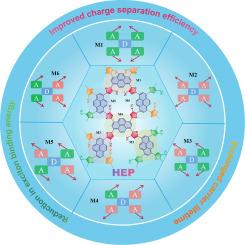Configurational disorder engineering in entropy-increasing conjugated polymers boosts photocatalytic performance
IF 14.3
1区 材料科学
Q1 MATERIALS SCIENCE, MULTIDISCIPLINARY
引用次数: 0
Abstract
High-entropy polymers (HEPs) represent a transformative approach to overcoming the intrinsic limitations of conjugated polymer photocatalysts through deliberate configurational disorder engineering. The designed high-entropy conjugated polymer Py-CNTh demonstrates exceptional photocatalytic performance, achieving hydrogen evolution and H2O2 production rates of 248.34 and 15.55 μmol h⁻1, respectively—representing 8.8 and 43-fold enhancements over conventional counterparts (Py-Th). Comprehensive characterization reveals that entropy-driven structural disorder induces synergistic optoelectronic enhancements, as evidenced by a 33% reduction in exciton binding energy and a prolonged carrier lifetime of 919 ps, both of which contribute to significantly improved charge separation efficiency. The high-entropy architecture further strengthens interfacial processes through enhanced built-in electric fields and improved hydrophilicity. Systematic studies across an entropy increase establish a direct correlation between configurational disorder and photocatalytic performance, highlighting the critical role of entropy in optimizing charge transport and surface reactivity simultaneously. This work establishes high-entropy engineering as a general design principle for advanced polymeric photocatalysts, offering new opportunities for solar energy conversion applications.

增熵共轭聚合物的构型无序工程提高了光催化性能
高熵聚合物(HEPs)代表了一种革命性的方法,通过刻意的构型无序工程来克服共轭聚合物光催化剂的固有局限性。所设计的高熵共轭聚合物Py-CNTh表现出优异的光催化性能,其析氢速率和H2O2产出率分别为248.34 μmol h- 1和15.55 μmol h- 1,比常规聚合物Py-Th提高8.8倍和43倍。综合表征表明,熵驱动的结构紊乱导致了协同光电增强,如激子结合能降低33%,载流子寿命延长到919 ps,这两者都有助于显著提高电荷分离效率。高熵结构通过增强内置电场和改善亲水性进一步加强了界面过程。系统研究在熵增加的过程中建立了构型紊乱和光催化性能之间的直接关联,强调了熵在同时优化电荷传输和表面反应性方面的关键作用。本研究建立了高熵工程作为先进聚合物光催化剂的一般设计原则,为太阳能转换应用提供了新的机会。
本文章由计算机程序翻译,如有差异,请以英文原文为准。
求助全文
约1分钟内获得全文
求助全文
来源期刊

Journal of Materials Science & Technology
工程技术-材料科学:综合
CiteScore
20.00
自引率
11.00%
发文量
995
审稿时长
13 days
期刊介绍:
Journal of Materials Science & Technology strives to promote global collaboration in the field of materials science and technology. It primarily publishes original research papers, invited review articles, letters, research notes, and summaries of scientific achievements. The journal covers a wide range of materials science and technology topics, including metallic materials, inorganic nonmetallic materials, and composite materials.
 求助内容:
求助内容: 应助结果提醒方式:
应助结果提醒方式:


